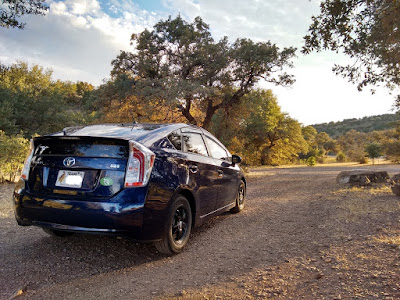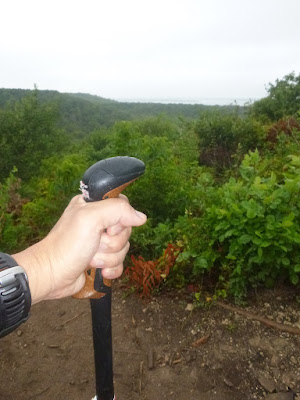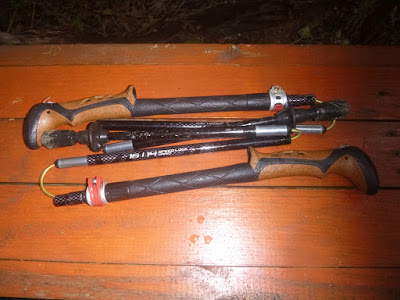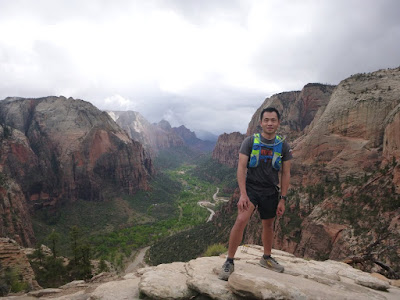I was supposed to run the Cactus Rose 100 Mile Endurance Run in Bandera, Texas last October, I had signed up on a whim, seeking a bit of redemption for the year after falling short at the Wasatch 100 Mile; my legs still felt strong after my DNF at the Monster in Utah, and I didn’t want to waste a good opportunity to run a race I had also DNF’d on a few years ago and have been itching to go back ever since and come home with it’s coveted buckle, but then a Hurricane rudely interrupted my plans. Hurricane Patricia hit the shores of Mexico just a day before Cactus Rose, there were multiple warning reports about potential road closures and for everyone to stay home if possible, a warning I heeded, but Ultra Runners are nuts, and the race was held anyway...amazingly, 26 hearty souls finished the 100 Miler while being rained on for most it, and running in ankle deep water and muddy trails, dunno if I’ll ever desire to take this sport to such extremes. In the meantime, I had the day off from work, when I should have been driving to Bandera, and was able to finally pull the trigger on another coveted object I’ve been obsessing about, my new adventure-mobile, a 2015 Toyota Prius!
My previous car was a 15 yr old Honda Civic that I drove into the ground, it was a rather reliable beast of burden, but very uncomfortable on trips longer than an hour, and was so old I was constantly afraid of it breaking down. This had the effect of limiting the races that I could do, either races within 200-300 mile radius, or I would have to fly (a very costly option) and blow up my racing budget for the year on just a couple of races. Now with a more comfortable ride (and Cruise Control!!!), that gets incredible gas mileage, and allows me the convenience of car camping; suddenly driving to races 600-1000 Miles away on a whim doesn’t seem like such a bad idea, and my racing schedule for 2016 subsequently got more ambitious.
 |
| Quite comfortable, actually. |
 |
| To Boldly Go...Exploring. |
More on my new Car and travel plans later, not choosing to run Cactus Rose did have a downside effect in leaving my legs too rested and under-trained; after Wasatch, I didn’t run much, after taking off 2-3 weeks to recover, there was only 3 weeks left before Cactus Rose to get in some easy miles under my legs. So when Cactus Rose didn’t happen for me, I lost my motivation to train with it...perhaps I needed the break anyway after a long summer training grind for Wasatch and the subsequent disappointment of falling short. I couldn’t afford to rest too long though, I had already set my sights on my first race of 2016 at the Big Bend 50 Mile, and proceeded to pound my legs back into shape; first with an easy 50K at Rockledge Rumble in mid November, then following that up 3 weeks later with a 37 Miler at McKinney Roughs 12 Hr. My legs responded, and recovered, well from those races, but I only had a good 3 weeks to get in some decent high Mileage training weeks, before tapering for Big Bend 50, and felt nervous for my first big test of the new year.
Big Bend 50 Mile at Big Bend Ranch State Park in Texas, has always been one of those races that I’ve been dying to run, a scenic desert run amongst the Cacti and Mesa’s down at the Southwestern border of Texas, and also a great excuse to visit the Big Bend National Park next door after the race; it’s a 600+ Mile drive from Dallas though, and wasn’t something I was willing to make in my old car, but this was one of the first races I considered after getting the Prius. Big Bend 50 was also a good race to test out my legs, it’s mostly flat and smooth dirt trails for most of the race, punctuated by a steep, rocky, and cacti covered climb up and down a thousand and half ft Mesa in the middle of the race, providing for a fast, scenic, and varied racing experience. I didn’t push myself too hard in this race, mostly because I had already signed up for a tough Mountain 50 Miler three weeks later, but also because I ran most of the race with a new friend, Janie. The trail markings wasn’t the greatest (one 6 mile section was completely unmarked…), so we decided to stick together to not get lost, also while I was stronger on the climbs and downhills, she was faster on the flats, so we complemented each other well in pushing each other towards the finish. Big Bend 50 turned out to be more like 53 and half miles, and I finished in around 14 and half hours, not great, but I was relieved my legs were back in 50 Mile shape after a long period of breaking them in again after Wasatch. For a grandview tour of the State Park at Big Bend, this race can’t be beat, and afterwards, I absolutely loved climbing at Big Bend National Park; with Mountains and views so Magnificent, I hardly believed I was still in Texas.
 |
| With Janie |
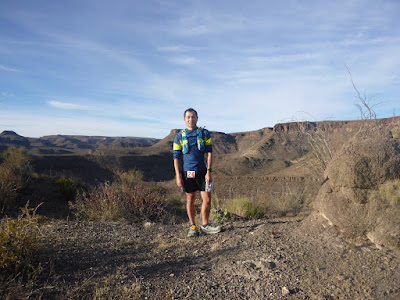 |
| I'm just here for the pictures... |
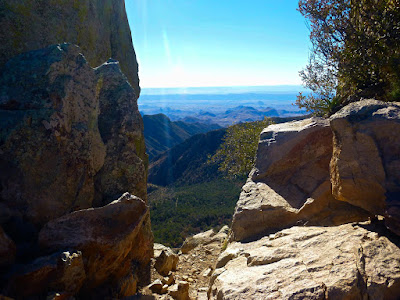 |
| This one is of Emory Peak at Big Bend National Park...stunning. |
My next race was nowhere near my radar in considering my racing schedule, but when a good friend ask if you want to bum along with him and a few other friends for a race on the Santa Monica Mountains in California, I immediately bought the plane tickets to join along without much consideration into exactly what I was getting into. I haven’t been to California since I was a little kid, and have been wanting to make the trip out west for years to experience the trails and mountains over there, at first glance, Sean O’Brien 50 Mile sounded very difficult with around a 11K ft of climbing, but doable with mostly smooth dirt roads and with a 15 hour cutoff...none of us bothered to check out the details beyond that before making the trip though. Days before the race, I finally gave those details a finer look, and my heart sank when reading it, I would have had to make the first 34 Miles in a blistering time of 8:45 hrs, that’s after climbing over 3,000ft in ten miles in the beating hot sun of mid-day…that cutoff was just unrealistic and in no way adjusted for a 15hr race, especially after such a huge climb in the heat. I knew there was no way I could’ve accomplished such a feat and intended to drop to the 50K, but my friends talked me back into the 50 Miler, I just wished I hadn’t left my trekking poles at home when I was still intending to drop to the lower distance. Out of the four of us that went, only one of us finished, Ace Gallegos in around 12 hours, felt really bad for his girlfriend Julie, a Gazelle of a runner, that got caught in that mile 34 cutoff trap, even though she was on pace to finish in 12 and half hours; as for me, I had to drop at Mile 30 in around 8 and half hours, a time that I was quite proud of, and if the cutoffs were adjusted right, I may have been able to squeak in under 15 hours...oh well. This gorgeous race on the Santa Monica Mountains, touring multi-million dollar hillside estates, and over-looking the Pacific Ocean, seemed like such a quintessential “California” race to me, would have loved to been able to finish it...for what it’s worth, when questioned by my friend, the RD was apologetic and assured us the cutoffs will be adjusted correctly for next year...so tempted to give it another shot.
 |
|
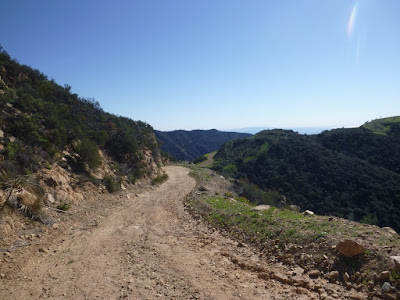 |
| I could get use to this... |
One positive outcome that came from my DNF at Sean O’Brien, was that I recovered quickly from “just” a Mountainous 30 Miler, and had the legs for my third go around at a favorite race of mine, a jewel in Arkansas, the Run LOViT 100K. Run LOViT is a challenging, fun, and beautifully scenic run on the Lake Ouachita Vista Trails, that has already inspired me to write two race reports on it (here and here). I especially love this race, because I consider it to be a good “indicator” race to gauge my fitness early in the year to take on more difficult Mountain races later on, and since it’s the closest to the Mountains that you’re gonna get from Dallas in a reasonable drive of just over 300 Miles. After finishing the race in 18:20 hours (and my first ever DFL!), I came away from it feeling a bit mixed about the shape of my fitness, but confident I could take on my first big challenge of the year, the Zion 100 Mile race in Southern Utah, 7 weeks later. My two big take-aways from Run LOViT 100K was, that while my running legs have gotten quite weak and slow after not focusing so much on that part of my training for such a long time, my Hiking legs were still strong and could go on seemingly forever. It was nice to know that the endless power-hiking drills for Wasatch last summer was still paying off, and while I fret a little about my much reduced running speed, Zion has a pretty generous cut-off of 34 hours, maybe I could grind out this finish I thought to myself...unfortunately, much like Sean O’Brien, I didn’t much check out the details before signing up for the race.
 |
| The early morning views of Lake Ouachita on top of Hickory Nut Mountain never gets old... |
When it came to the Zion 100 Mile run, I didn’t care much for details, save for the “doable” elevation profile of just 10K ft worth of climbing, my main reason for signing up was to travel back up to Southern Utah and explore more, particularly the National Park next door to the race. Much like I did with Big Bend 50, it was a good opportunity to explore the more local trails in and around the town of Virgin, Utah just a spitting distance away from Zion, and afterwards I could spend all weekend hiking the trails at the majestic National Park; it’s a great way to pack in as much miles and sights as you possibly can in a few short days. I was all ready to give the 100 Mile a go, when suddenly the Race Director of Zion started sending frantic emails warning of rain during the race, and how badly the course’s mostly dirt clay roads and trails can turn into unrunnable and slippery pig slop. The RD gave us the option to drop completely and be credited for a future race with his organization at Ultra Adventures, something I considered briefly, especially remembering how impossibly horrible muddy clay can be to run on at a local North Texas race that I did last year (Big Cedar), but it looked like rains were projected to fall mostly overnight and into the next day, leaving the first day of the race with spectacularly cool and cloudy weather; so instead of dropping completely, I changed my registration to the 100K, been looking forward to this trip for too long to turn back now.
Traveling long distances solo can suck, especially when you’re going to be stuck in a car for two days by yourself just getting to the destination, but I got plenty of Podcast, music, and other audio programs to keep me occupied, and sorta look forward to making these long road trips to work down my Podcast queue; there’s something about the driving experience that makes listening to an audio story that much more engrossing. Also, I was originally going to fly, but it’s vastly less expensive to drive and camp out in my car when possible; I didn’t exactly buy a Prius to “go green”, I mainly bought it to support my traveling and racing habit, and will most likely end up driving twice as far as my previous car yearly! On my way to Zion, I had a couple hours to spare to finally see the big ditch in Arizona for the first time in my life, and it was every bit as Grand as it’s namesake implies; someday I’ll be back to the Grand Canyon National Park for a R2R2R attempt. Finally making to the race site, where I got to camp about a hundred feet from the starting line, I was curious about the number of people who dropped due to all the dire warnings of a potential apocalyptic mud-bath, in total, from the 100 Miler, three people dropped down the 100K (including me) and only ONE person dropped completely…yeah, Ultra Runners are nuts.
 |
| Yeah...it's quite Grand. |
The beginning 13 miles on the first big climb of the day up and down a +1,500ft Mesa (not quite so sure on the terminology between Mesa and Plateau, but says Mesa on topography maps) to the Dalton Walsh Aid Station went smoothly; the morning was cool and my legs felt strong on the steep and rocky climb, and the dirt roads and trails up on the Mesa was rather smooth and runnable, this leg of the race went by quickly in 3 and half hours and I felt good about my prospects for the rest of the day...oh how quickly things can go downhill in an Ultra. It was starting to heat up, cool temps, cloud cover, and some rain wouldn’t arrive till mid-way into the race, and the 5 miles of hard-packed dirt roads, going up hill to the next aid station, felt like concrete to run; I found it difficult to run much and was doing too much walking during this stretch; my weak running legs became all too plain to see. Once I muddled my way to the Guacamole Aid Station at mile 18, hoping for some smoother single track trails and some shade cover, I found neither as the next nearly 8 miles were ran on rough and uneven “rock domes” that was confusing to navigate and tore up my feet some more. This uniquely frustrating section, as best as I can describe it, could be rather fun navigating your way over the wavy rock domes, going from cairn to cairn, but I was slowed down significantly making my way through this section; all told, it took me over 2 and half hours just to make it back to Guacamole aid station.
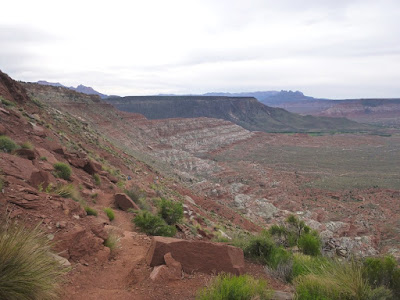 |
| The View from up top the Mesa |
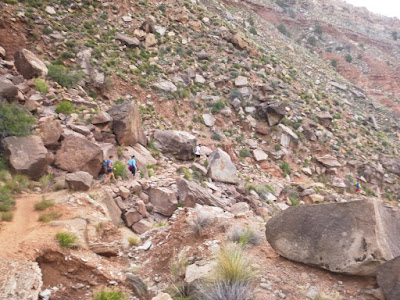 |
| It can get quite rocky and treacherous going down the Mesa at breakneck speed... |
 |
| Some quite scenic stretches on this dirt road to Guacamole A/S |
 |
| Beginning of the blasted rock domes... |
 |
| Try not to think dirty thoughts...I dare you. |

If more of trails up ahead were like those rock domes, I knew making the 16 hour cutoff at mile 48 would be dicey, as I was averaging 20 min/miles trying to navigate them. The downhill trip from Guacamole to Dalton Walsh Aid Station went by smoothly, as cloud cover and cool temps started blowing in, and it felt great to actually be able to run again. Shortly after leaving Dalton Walsh though, it started getting hot again, and the next 3 and half miles were hard-packed dirt roads that were unforgiving on my 30+ mile legs at that point. All along this long and straight dirt road you can see the Gooseberry Mesa looming ahead of you ever larger and more dreadful; good thing I had my trekking poles with me to make this shockingly steep climb that required ropes in certain sections. All while I was dragging myself, inch by inch up this thousand ft climb, I couldn’t help but to be blown away by the views down below, this climb by far has the best views of the race, with multi-layered Mesa’s of different colors, shapes, and sizes stretching across the cloudy horizon; one tends to forget their struggles of the day, however so briefly, at the sight of such grand marvels.


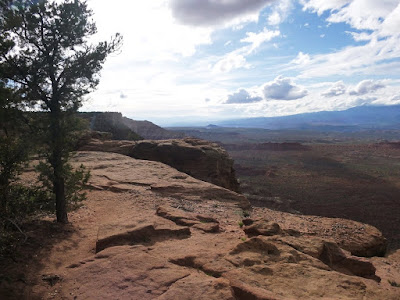 |
| Mesa porn... |
 |
| Love this one... |
In what seemed like forever, I finally made it on top of the Mesa to the Goosebump Aid Station at Mile 35.5, filled up on cheesy quesadillas with avocado (my new favorite trail food!), grabbed my rain shell and headlamp and made it out of there quickly. I now had 4 and half hours to make the next 12 miles to Gooseberry Aid Station and back, to meet the 16 hr cutoff at mile 47.5; with a relatively flat terrain profile, normally I wouldn’t be sweating this, but I was worried about running into those infuriating rock domes again, especially with night approaching. Sure enough, nearly the entire 12 mile trip was covered in these rock domes, and what made it even more of a confusing slog, was that there were no clearly flagged cairns to follow on this Mesa like the last dome section. Instead you’re mostly relying on painted white dots that was not put there by the race organization, that if you're not careful, could lead you astray for a quarter mile before realizing it; I got lost several times this way, and it didn’t help that the flags became even more spread out in this stretch, forcing you to keep moving forward sometimes just hoping you’re going in the right direction. All through the race, we got lucky, the rains up till now (around 12 and half hours in) had only came down in brief sprinkles and the clouds and cold breezes they brought in were much welcome relief, but a few miles out from finally reaching one of the signature defining features of this race, the Gooseberry Point Overlook, the rains came down in buckets. Thankfully, the rains were brief, and by the time I reached Gooseberry Point Overlook, the clouds had cleared a bit for one last spectacular view up on top of the Mesa.
 |
| My most epic race shot is one with my back turned and not running... |
 |
| Nighty night Mesa's... |
Just before I reached the Gooseberry Point Overlook (and aid station), I caught up to a couple that I mostly did the previous rock dome section with between miles 18-26, they were moving slow and frequently gotten lost trying to follow those white dots; after a few miles, I finally had to run on ahead, there was still a slight chance I could meet the cutoff if I rushed. Nightfall had finally arrived with about 5 miles left to go, and as I feared, navigating the rock domes became a nightmare in the dark, slowing you down to a crawl as you’re always on the lookout for white dots with your headlamps, that had a tendency to either vanish on you, or branch off in entirely different directions. As I was frustratingly averaging 26-28 min/miles by this point, my hopes of making the cut-off vanished with it, and I ended up coming short by 15 minutes resulting in another disappointing DNF.
I, quite frankly, didn’t think the Zion 100K course would be so difficult, it had a similar elevation profile to Run LOViT 100K, which I easily finished, and I assumed I could do the same here. It’s just those minor details that I overlooked, like miles upon miles of never-ending miles of bewildering rock domes, that would have came in handy if I had known (like actually read a race report on Zion…); maybe I would have trained harder for this race instead of just trying to trudge my way through another Ultra. Early spring races have always been difficult for me though, with the miserable Winter months of Texas making it difficult to train, and running so much Ultras back to back to back so early into this year didn’t help either; I didn’t have much time to train properly before I had to taper for the next race.
The main couple of things that I’m painfully aware of through racing so much this year, is that I need to become a stronger runner again, while I was focusing so hard on power-hiking last year, my running speed has almost entirely vanished; on races with long stretches of flats like in Zion, it’s crucial to have the speed to be able to take advantage of them so you’re not too hurt by the slower climbs and highly technical terrain. Another aspect that I need to focus harder on is nutrition and race preparation, when I was traveling with Ace and Julie, I marveled at how they’ve gotten their nutrition and race preparation down to a science. As they were laying out all their bags of white powdered CarboPro drink mix and little baggies of anti-fatigue/energy/endurolytes/salt pills on the hotel bed, with every single mile accounted for in dosage, it was like they were running a highly efficient drug operation (surprised they got through TSA screening...), these guys were Pro’s, and their racing results proved it; while here I am not even bothering to pack gels and relying on what I can find at the aid stations, no doubt all the extra time I spent at the aid stations eating and taking down calories would have made up for those 15 minutes I went over the cutoff.
Now that I’ve gotten these early Ultra’s out of the way, and most importantly, survived them injury free, I can start focusing more on training and getting my speed and mileage back up, and work on the other intangibles of racing. It was partly my objective all along, to take things easier and to merely survive my early races till I get to this point, but it doesn’t exactly take the sting out of slow finish times and DNF’s any easier...if I’m ever to become better at Ultras, I have to stop making excuses and put in the work, no more relying on a strong power-hike as a crutch, there’s too many races I want to see and conquer; namely Kat'cina Mosa 100K in August and Run Rabbit Run 100 Mile in September.

